
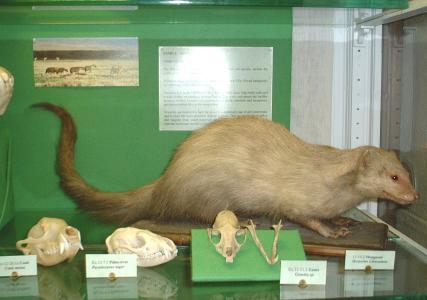
ORDER CARNIVORA
FAMILY HERPESTIDAE
MONGOOSES
General features and members of the family Herpestidae.
The mongooses belong to one of four families of terrestrial cat-like mammals descended from the Viverraines, which were civet/genet-like mammals. The mongoose family is a close evolutionary relation of the family Viverridae and mongooses are sometimes classified as members of this family. However mongooses have characteristic and distinguishing morphological and behavioural features. In contrast to the arboreal, nocturnal viverrids, mongooses are more commonly terrestrial and many are active during the day. Most are solitary like the Egyptian mongoose but a few, for example meerkats, have well-developed social systems.
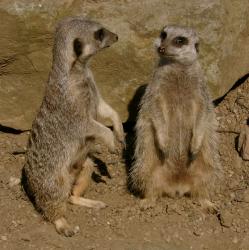 |
| Meerkats (Suricata suricatta) |
Mongooses have long faces and bodies, small rounded ears, short legs and long tapering tails. Most are brindled or grizzled; few have strongly marked coats.
Less diverse than the viverrids, the 35 species and 17 genera of mongooses are assigned to only two subfamilies. The subfamily Herpestinae comprises 30 species of African and Asian mongooses, including the Cape gray mongoose, the Egyptian mongoose and the meerkat or suricate. The subfamily Galidiinae comprises the five species of Madagascan mongooses.
Mongooses are distributed throughout North Africa, Sub-Saharan Africa, the Middle East and Asia living in a variety of habitats from forests to open woodland, savanna, semi-desert and desert. Chiefly terrestrial some are aquatic or semi-arboreal.
Life styles
 |
| Egyptian mongoose |
The Egyptian mongoose (Herpestes ichneumon) is an example of a solitary mongoose. Each female has a territory, which she defends against other females. Males defend larger territories that overlap with those of several females. Males and females rarely interact outside mating periods. Feeding on prey like mice, snakes and lizards requires stealth and is best done alone.
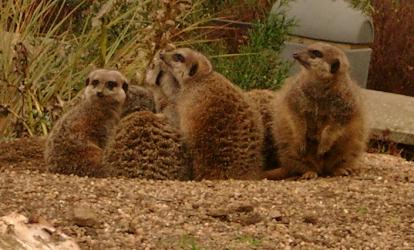 | 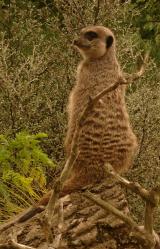 |
| Family of meerkats | Meerkat sentinel |
The meerkat or suricate (Suricata suricatta) lives in troops of 2- 3 families each comprising a male, a female and 2 - 5 offspring in open country in Southern Africa (Angola, Namibia, Botswana, South Africa). Meerkats are small, diurnal mammals foraging for invertebrates in open country. Their behaviour and small size (they weigh less than a kg) makes them very vulnerable to larger carnivores and birds of prey. To protect the foraging troops from predators, one meerkat serves as a sentinel - climbing to an exposed vantage point and scanning the surroundings for danger. If the sentinel detects a predator it gives a loud alarm call to warn the troop and indicate if the threat comes from the air or the ground. If from the air, the meerkats rush as fast as they can to the nearest hole. If from the ground, the troop flees but not quite so fast as meerkats are more able to evade terrestrial predators than airborne raptors.
Skulls, dentition and diet
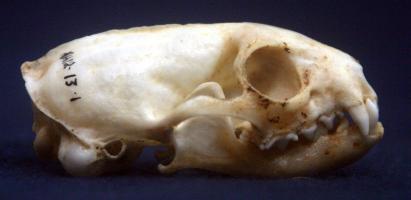 |
| Cape Grey Mongoose (Herpestes pulverulentus) skull (Dental formula: I3/3, C1/1, PM 3-4/3-4, M 1-2/1-2 = 40). |
Mongooses are mainly carnivorous feeding on small vertebrates, insects and other invertebrates, crabs, fish, birds' eggs plus carrion and fruit. Their long non-retractile claws are used to dig for food: the mongoose sniffs along the surface of the ground and when it finds an insect it snaps it up or, if necessary, digs it out. Some species, e.g. H. edwardsii, the Indian gray mongoose, kill and eat venomous snakes. Their basic dental formula is the same as the viverrids.
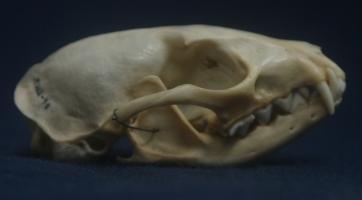 |
| Meerkat (Suricata suricatta) skull (Dental formula: I3/3, C1/1, PM 3-4/3-4, M 1-2/1-2 = 40). Meerkats forage and dig for invertebrates like grasshoppers and scorpions. |
| Dog-like carnivorans | Aquatic carnivorans | Cat-like carnivorans |
|---|---|---|
|
|
|






